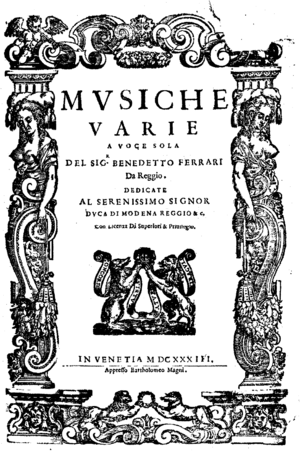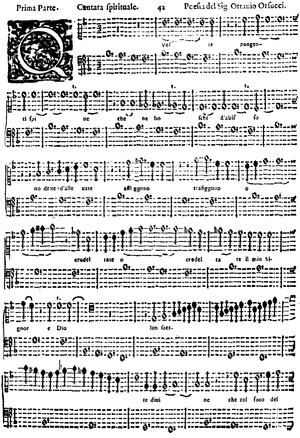Difference between revisions of "Queste pungenti spine"
| Line 141: | Line 141: | ||
==Manuscripts and sheet music== | ==Manuscripts and sheet music== | ||
[[File: | [[File:Queste pungenti spine.png|thumb|alt=Beginning of "Queste pungenti spine"|Beginning of "Queste pungenti spine"<ref name="IMSLP2"/>]] | ||
*{{cite web | *{{cite web | ||
|url=https://imslp.org/wiki/Musiche_varie_a_voce_sola_(Ferrari%2C_Benedetto) | |url=https://imslp.org/wiki/Musiche_varie_a_voce_sola_(Ferrari%2C_Benedetto) | ||
| Line 152: | Line 152: | ||
|url-status=live | |url-status=live | ||
|quote= | |quote= | ||
}} | }} | ||
==References== | ==References== | ||
{{Reflist|refs= | {{Reflist|refs= | ||
Revision as of 21:49, 29 September 2021
| Musiche varie | |
|---|---|
| by Benedetto Ferrari | |
 Musiche varie a voce sola, book one | |
| Full title | Musiche varie a voce sola |
| Libretto | |
| Published | 1633–1641 |
"Queste pungenti spine" is a piece written and composed by Benedetto Ferrari and is contained in Book II of his Musiche Varie, published in 1637.[1] The librettist is Ottavio Orsucci.[2]
It appears on the following album:
| Year | Album | Ensemble | Conductor |
|---|---|---|---|
| 2003 | Musiche Varie (Album) | Ensemble Artaserse | Philippe Jaroussky |
Libretto
from Musiche Varie, Book II
Benedetto Ferrari (music), Ottavio Orsucci (words)
Occhi miei, che vedeste | |
Ancient Italian | |
Occhi miei che vedeste(1) (1)Originally probably spelled "Ochj miei, ..:", with the "i lunga" replacing the double "i" that would logically appear in the plural.[6] | |
Manuscripts and sheet music

- "Benedetto Ferrari". IMSLP. Retrieved September 21, 2021.
References
- ↑ "Benedetto Ferrari". OPAC. Retrieved September 21, 2021.
- ↑ 2.0 2.1 Cite error: Invalid
<ref>tag; no text was provided for refs namedIMSLP2 - ↑ English translation by FR (Lankin), 2021
- ↑ Linguistic advice: VC, 2021
- ↑ "Benedetto Ferrari, Musice Varie, Book one: RISM A/I: F 265". IMSLP. Retrieved September 21, 2021.
- ↑ Delle Opere del Cavalier Battista Guarini. Tomo Secondo. Nel quale si contengono Le Rime stampate ed'Inedite. Verona: Giovanni Alberto Tumermani. 1737.
Cite error: <ref> tag with name "Wiki" defined in <references> is not used in prior text.
<ref> tag with name "IMSLP" defined in <references> is not used in prior text.
References
<ref> tag defined in <references> has group attribute "" which does not appear in prior text.